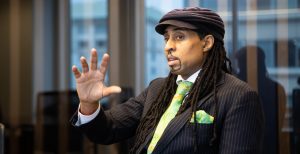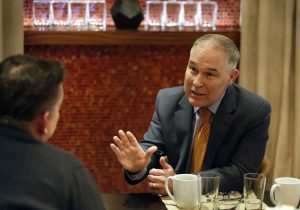
“With Scott Pruitt, you had someone who had built a career on trying to dismantle and deconstruct basic environmental protections. So for me, that’s a person who is not qualified.”
Mustafa Santiago Ali knew it was time to leave EPA.
It was March 2017, and Ali had spent 24 years at the agency, working under both Democratic and Republican administrations. He related his story about his resignation in an interview with E&E News.
But something about the Trump administration was different.
Political appointees — including then-EPA Administrator Scott Pruitt — didn’t seem interested in his work on environmental justice. They seemed more keen on pursuing regulatory rollbacks that opponents warn could lead to thousands of illnesses and premature deaths.
After submitting his resignation letter to Pruitt, Ali became senior vice president for the Hip Hop Caucus, which works with hip-hop artists to get more people engaged in the civic process.
He now serves as vice president of environmental justice, climate and community revitalization at the National Wildlife Federation — a role that entails frequent appearances on Capitol Hill.
E&E News recently sat down with Ali at the National Wildlife Federation office to discuss his involvement in creating EPA’s Office of Environmental Justice, his work with Democratic presidential candidates, and the power of artists like Beyoncé and Lizzo.
How did you first become interested in environmental justice?
I got into social justice issues when I was a teenager. I come out of a family of ministers, deacons and deaconesses who are very focused on social justice and civil rights issues. My dad was especially focused on standing up for workers’ rights. So my family made sure that all the kids had to give back. We got to decide what that would look like and what the issues would be, but we shouldered that expectation.
You first came to EPA when you were 16 years old, right?
Yes. I came to the Environmental Protection Agency because they had a program at the time to get minority students more engaged in environmental issues. It was called the Environmental Careers Organization. There were about 300 of us. It started under the [George H.W. Bush] administration and really took off under the [Clinton] administration.
Who led the program?
Dr. Clarice Gaylord was very instrumental in the program. There were a lot of other folks there, but I want to give her credit for really valuing young people and making sure that students got real experience. And she later went on to become the first director of EPA’s Office of Environmental Justice.
You were involved in the creation of that office. How did that come about?
It actually came out of a set of recommendations in the late ’80s and early ’90s from something called the Michigan Working Group. A number of different leaders — grassroots leaders, civil rights leaders, public health leaders — got together and identified a series of actions that the federal government needed to take. And one of them was the creation of the Office of Environmental Equity, which later became the Office of Environmental Justice. It also helped put the foundation together for Executive Order 12898 that President Clinton signed, which is often known as the environmental justice executive order.
You were at EPA for 24 years. Why did you decide to leave the agency under President Trump?
I decided to leave the agency because I knew its actions were not just going to be detrimental to vulnerable communities, but they would also have deadly consequences. About 100,000 people die prematurely each year from air pollution. So if we weakened air pollution standards, more people would die.
I grew up with the quote, “When someone shows you who they are, believe them.” This administration was showing us who they were. And they were going to be very dangerous for the country as a whole, but especially for communities of color, low-income communities, working-class white communities and indigenous communities. So I knew I couldn’t be a part of that.
Your resignation letter to then-EPA Administrator Scott Pruitt was widely circulated in the media. What was that like?
Reporters have actually shared with me that my resignation letter has been read over a million times. I was really hoping that people — and when I say people, I meant at the time Administrator Pruitt and President Trump — would take a serious look at what was going on. That’s the reason I stood up. I had no idea it would become as big as it did.

What were your thoughts on Pruitt?
Let me say this: I worked under Democratic and Republican administrations over the years, and there were positives and negatives with all the administrations. But this administration places people in positions of power who should not be there. If you look at [Housing and Urban Development Secretary Ben Carson], you have a person who is brilliant when it comes to medicine and surgery but doesn’t know anything about housing.
With Scott Pruitt, you had someone who had built a career on trying to dismantle and deconstruct basic environmental protections. So for me, that’s a person who is not qualified. They have been very intentional in not bringing the right people in who live up to the mission of what they’re supposed to.
Did you ever interact with Pruitt?
I tried a few times. Usually when an administration changes hands and new folks come in, they’ll ask you probing questions and engage you. But the times that I tried to interact with them, I never got a response back. And that sent a very clear message that environmental justice was not a priority.
Before joining the National Wildlife Federation, you served as senior vice president of the Hip Hop Caucus. What was that like?
Oh, it was incredible. The Hip Hop Caucus is a fantastic organization. Working in conjunction with artists and entertainers, we really tried to get more people engaged in voting, especially people from communities that are often unseen and unheard. And we were serious about trying to win on climate change and environmental justice.
I often say that I know 1,000 of the best scientists around the world, and if they say something, 10% of people might pay attention. But if Beyoncé or Jay-Z or Lizzo says something, people pay attention. So when [Hurricane Harvey] came through Houston and Beyoncé started to get engaged, lots of other people began to get engaged.
Is environmental justice getting more attention now on Capitol Hill?
Oh, without a doubt. It’s amazing. My grandfather used to say, “Sometimes you plant a seed and it’s not going to necessarily come up the next year, but eventually it will come up.” And we’re at a point now where environmental justice is becoming a part of the mainstream dialogue. It’s no longer an afterthought or a niche issue. And on Capitol Hill, there have been a number of hearings and pieces of legislation.
Have the Democratic presidential candidates made environmental justice a priority?
I think you have a number of presidential candidates who are talking about environmental justice and climate justice in a substantive way. I try to help whoever is interested.
Which candidates have you worked with?
Maybe I’ll leave that part alone. I’ll just say that I’m close with six or seven of the candidates. Some of them are no longer in the race. Tom Steyer understands the dynamic. Bernie Sanders has been talking about environmental justice for a number of years. Elizabeth Warren can also talk about it in a very substantive way. And we all know Elizabeth’s got a policy for everything, and rightly so.
Cory Booker actually went on a tour with me around the South before he ever ran for president. We went and checked out certified animal feeding operations, hog farms, and saw how waste was being sprayed and would come onto people’s houses and clothes. He also checked out Cancer Alley and a number of other places in between.
So, all being said, there are a number of the candidates, both past and present in this particular cycle, who are very focused on environmental justice. And that is different because if you go back and you look at any of the previous presidential cycles, you did not have folks talking about it.
Source: E&E News



